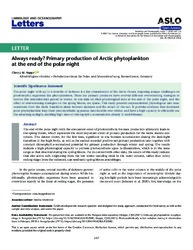Always ready? Primary production of Arctic phytoplankton at the end of the polar night
DOI: https://doi.org/10.1002/lol2.10222
Persistent URL: http://resolver.sub.uni-goettingen.de/purl?gldocs-11858/10068
Persistent URL: http://resolver.sub.uni-goettingen.de/purl?gldocs-11858/10068
Hoppe, Clara J. M., 2021: Always ready? Primary production of Arctic phytoplankton at the end of the polar night. In: Limnology and Oceanography Letters, Band 7, 2: 167 - 174, DOI: 10.1002/lol2.10222.
 |
Dokument öffnen: |
The end of the polar night with the concurrent onset of photosynthetic biomass production ultimately leads to the spring bloom, which represents the most important event of primary production for the Arctic marine ecosystem. This dataset shows, for the first time, significant in situ biomass accumulation during the dark–light transition in the high Arctic, as well as the earliest recorded positive net primary production rates together with constant chlorophyll a‐normalized potential for primary production through winter and spring. The results indicate a high physiological capacity to perform photosynthesis upon re‐illumination, which is in the same range as that observed during the spring bloom. Put in context with other data, the results of this study indicate that also active cells originating from the low winter standing stock in the water column, rather than solely resting stages from the sediment, can seed early spring bloom assemblages.
Statistik:
ZugriffsstatistikSammlung:
Schlagworte:
Arcticmarine ecosystem
phytoplankton
polar night
phototrophic organisms
biomass accumulation
This is an open access article under the terms of the Creative Commons Attribution License, which permits use, distribution and reproduction in any medium, provided the original work is properly cited.

